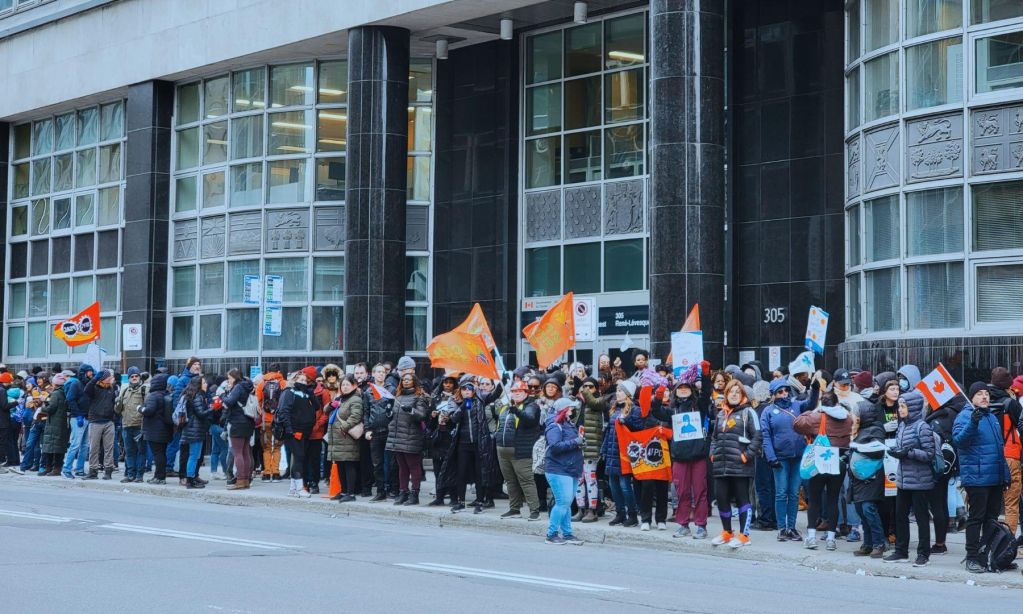As over 150,000 federal public sector workers continue striking for a new contract, it’s important to understand where those workers sit within the broader labour market. How does public sector pay compare to the pay in other sectors?
Federal public sector workers are indeed paid more than the average worker, but many of the tasks they perform require higher levels of education and training than the average worker. In a Canada Revenue case where a corporation is arguing it shouldn’t have to pay taxes, you don't want a junior law clerk arguing the government side. You want the CRA to have experienced and competent lawyers and accountants to go up against the high-priced accountants and lawyers that a big company is going to bring to court.
If we take the proportion of workers with a bachelor's degree by industry, we find that 48 per cent of federal public sector workers have a bachelor's degree (this is a rough proxy for education in that it excludes other post-secondary accreditations, but it’s merely for rough illustration).
Of the 101 industries with data, federal public administration workers are the 10th highest on education. Industries with more educated workforces are going to have to pay more in general and industries with fewer workers holding a university degree have lower pay. This rough metric is illustrated in Figure 1
Federal public sector workers are actually slightly below the general trend line—meaning they are slightly underpaid based on the education metric, although not by much. On the other hand, workers in the management of companies or pipeline transportation industries have roughly the same education level but are paid far more. In some industries with much lower education levels, like petroleum and coal manufacturing (otherwise known as oil refining), only 21 per cent of workers have a bachelor's degree—yet their pay is almost twice as high as that of federal government workers.
Education isn't everything. For a fairer comparison, it would be good to include more factors like occupation, age (as a proxy for experience), work effort, gender, geographic region, racial status and so on. When taking those items into account, generally the public sector (not only federal public administration) gets paid 2 per cent more than private sector employees (in contrast to the graph above, which only adjusts for education).
Basically, this amount is so small that public sector pay is roughly the same as private sector pay. Although this equivalence hides big differences behind a broad average. (Unfortunately, this needs to be updated to the 2021 census and this level of detail hasn’t been released yet.)
We need to look under the hood of these broad conclusions. Turns out that university-educated male workers make $7,000 less per year in the public sector—so they’d actually make more by switching to the private sector. This is driven in areas like management, which is paid at far higher rates in the private sector through million dollar bonuses. That doesn’t happen in the public sector.
But other groups get paid more in the public sector than the private sector—specifically women, racialized and Indigenous workers. Even with similar education levels and occupations, workers from these groups are routinely paid less in both the public and private sector, but the gap is smaller in the public sector.
That greater equity in public sector pay is what drives the minor “premium” that the average public sector worker enjoys. It is a reflection of the fact that some workers aren’t quite as discriminated against in the public sector as they are in the private sector. That's one of the values of union representation—your co-workers are setting the conditions for a more equitable and fairer workplace.
For every dollar that a university-educated man makes, a university-educated woman in the private sector makes 73 cents. The public sector is better—providing university-educated women with 82 cents for every dollar a man makes. That’s the trade off, men get paid less in the public sector so women aren’t quite as discriminated against there.
It's a similar situation for racialized workers. The biggest correction by the public sector is for university-educated Indigenous workers, who are paid 56 cents in the private sector for every dollar that a non-Indigenous worker is paid. That gets improved to 86 cents if they work in the public sector. Again, this higher level of equity drives slightly higher average pay for public sector workers.
High inflation is eroding whatever increased equality may have been gained by shrinking the pay gaps in these areas. Inflation jumped above 3 per cent in April 2021 and it hit the public sector hard. Private sector workers who are not in unions have gotten pay increases that are slightly above inflation and they are actually slightly better off now than before inflation kicked off, even when adjusting for inflation.
The risk is that without wage gains for public sector workers, the increased equity for women, racialized and Indigenous workers will be eroded by inflation.
Public sector unions' commitment to pay equity legislation, higher union density, and policies that support work-life balance have resulted in a more equitable pay system. While some may argue that the public sector should be more like the private sector, such a move would come at a high cost to the most vulnerable workers. It would mean pay cuts for women, Indigenous and racialized workers so that male managers can get a big pay raise, just like in the private sector.
Less discrimination against women, Indigenous and racialized workers isn’t a wage premium, it's a condition of a fairer society. Replicating pay gaps from the private sector is not only a loss for those workers and a loss to the economy, it is a step towards a less equitable society.







